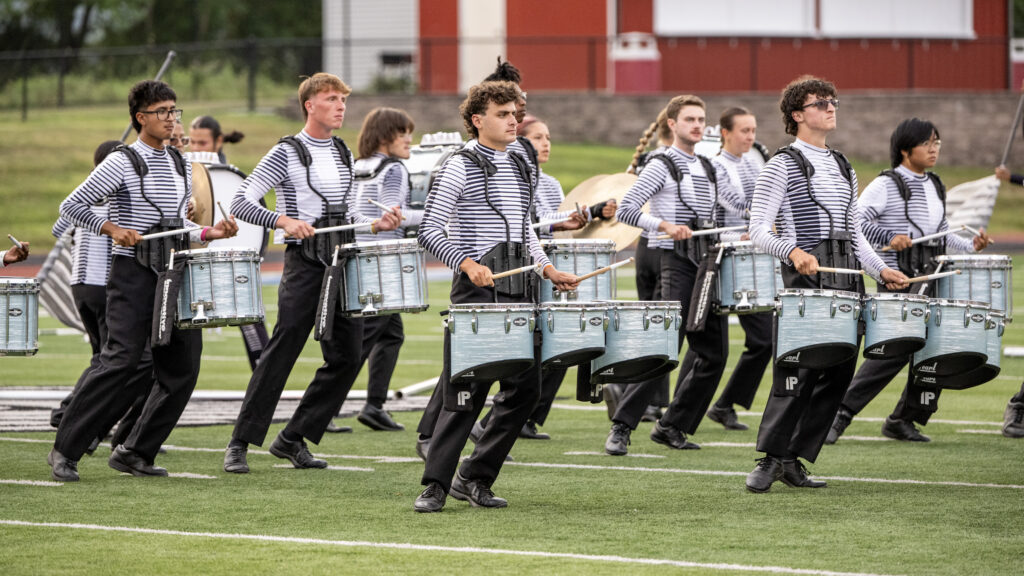
2010 Blue Knights
The music was written as incidental music to a play, the title loosely translated as “The Girl from Arles.” The play was not a success and closed soon after opening. The second suite from the incidental music was arranged for full orchestra by Ernest Guiraud and published in 1879, four years after Bizet’s death. “Farandole” was the final of the four movements and became an instant success.
Starting quietly with a soft interpretation of the main theme, it took a half-minute until the brass section hit the audience over the head with a grand exclamation of the melody that everyone knows. A trumpet solo accompanied by a snare drum soloist was answered by a mellophone player accompanied by a tenor drummer. The piece built up steam before the entire color guard unveiled orange flags that matched the color of their costumes. These were introduced just prior to a moment of silence highlighted by the brass players tipping their heads during a simple “ding” from the orchestra bells.

Nathalie Fournier
Two movements from Edward Elgar’s “Enigma Variations” were the heart of the show, changing the production’s demeanor with a sense of serenity that was highlighted by the color guard changing costumes and flags from orange to blue. An enigma is something considered obscure, difficult to understand or mysterious. The generally known title of the orchestral source material is the commonly used name for Elgar’s “Variations on an Original Theme for Orchestra, Op. 36.” Consisting of a theme with 14 variations, the work from the last two years of the 1800s is the British composer’s best-known large-scale work.
The title “W.N.” stood for Winifred Norbury, a friend whom Elgar found to be relaxed and laid-back. This segment was used solely as a front ensemble percussion introduction to “Nimrod,” the most famous work from the set.
The haunting beauty of “Nimrod” has strong emotional connections to the British people. The piece is played at many solemn occasions, including funerals and memorial services. Instead of pushing forward during the climactic hit, the Blue Knights stood still to unleash the final impact, which was the show’s most emotional moment.
Johnnes Brahms’ “Symphony No. 1” was completed in 1876 after a tedious period of 21 years. Colors in the guard costumes and flags turned lime green, with hints of purple, as a percussion mallet-based transition introduced “Movement 4, Adagio.” This movement was based on an Alpine shepherd tune originally set to the words, “High on the hill, deep in the dale, I send you a thousand greetings.” The symphony, and especially this movement, is often regarded as referencing Beethoven’s “Symphony No. 9,” “Ode to Joy,” from a half-century earlier.
The simple, passionately soaring melody of the symphony brought the show to a joyous conclusion and left fans humming the unforgettable tune during the break between corps that followed.
For this week only, you can save on the DVD that contains this complete Blue Knights performance, along with all of finalists corps at the 2010 DCI World Championship. Buy the 2010 World Championship DVD set. (Available this week only for 20% off. Regular price: $45.95.) Discount DVD offer ends Monday, Feb. 18 at 8:30 a.m. ET.

Michael Boo was a member of the Cavaliers from 1975-1977. He has written about the drum corps activity for more than a quarter century and serves as a staff writer for various Drum Corps International projects. Boo has written for numerous other publications and has published an honors-winning book on the history of figure skating. As an accomplished composer, Boo holds a bachelor's degree in music education and a master's degree in music theory and composition. He resides in Chesterton, Ind.





